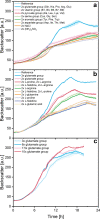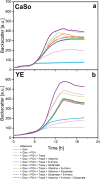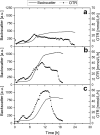Revealing nutritional requirements of MICP-relevant Sporosarcina pasteurii DSM33 for growth improvement in chemically defined and complex media
- PMID: 33384450
- PMCID: PMC7775470
- DOI: 10.1038/s41598-020-79904-9
Revealing nutritional requirements of MICP-relevant Sporosarcina pasteurii DSM33 for growth improvement in chemically defined and complex media
Erratum in
-
Publisher Correction: Revealing nutritional requirements of MICP-relevant Sporosarcina pasteurii DSM33 for growth improvement in chemically defined and complex media.Sci Rep. 2022 Feb 1;12(1):2017. doi: 10.1038/s41598-022-06174-y. Sci Rep. 2022. PMID: 35105924 Free PMC article. No abstract available.
Abstract
Microbial induced calcite precipitation (MICP) based on ureolysis has a high potential for many applications, e.g. restoration of construction materials. The gram-positive bacterium Sporosarcina pasteurii is the most commonly used microorganism for MICP due to its high ureolytic activity. However, Sporosarcina pasteurii is so far cultivated almost exclusively in complex media, which only results in moderate biomass concentrations at the best. Cultivation of Sporosarcina pasteurii must be strongly improved in order to make technological application of MICP economically feasible. The growth of Sporosarcina pasteurii DSM 33 was boosted by detecting auxotrophic deficiencies (L-methionine, L-cysteine, thiamine, nicotinic acid), nutritional requirements (phosphate, trace elements) and useful carbon sources (glucose, maltose, lactose, fructose, sucrose, acetate, L-proline, L-alanine). These were determined by microplate cultivations with online monitoring of biomass in a chemically defined medium and systematically omitting or substituting medium components. Persisting growth limitations were also detected, allowing further improvement of the chemically defined medium by the addition of glutamate group amino acids. Common complex media based on peptone and yeast extract were supplemented based on these findings. Optical density at the end of each cultivation of the improved peptone and yeast extract media roughly increased fivefold respectively. A maximum OD600 of 26.6 ± 0.7 (CDW: 17.1 ± 0.5 g/L) was reached with the improved yeast extract medium. Finally, culture performance and media improvement was analysed by measuring the oxygen transfer rate as well as the backscatter during shake flask cultivation.
Conflict of interest statement
The authors declare no competing interests.
Figures






Similar articles
-
Feeding strategies for Sporosarcina pasteurii cultivation unlock more efficient production of ureolytic biomass for MICP.Biotechnol J. 2024 Apr;19(4):e2300466. doi: 10.1002/biot.202300466. Biotechnol J. 2024. PMID: 38581094
-
Beneficial factors for biomineralization by ureolytic bacterium Sporosarcina pasteurii.Microb Cell Fact. 2020 Jan 23;19(1):12. doi: 10.1186/s12934-020-1281-z. Microb Cell Fact. 2020. PMID: 31973723 Free PMC article.
-
Publisher Correction: Revealing nutritional requirements of MICP-relevant Sporosarcina pasteurii DSM33 for growth improvement in chemically defined and complex media.Sci Rep. 2022 Feb 1;12(1):2017. doi: 10.1038/s41598-022-06174-y. Sci Rep. 2022. PMID: 35105924 Free PMC article. No abstract available.
-
Insights into the Current Trends in the Utilization of Bacteria for Microbially Induced Calcium Carbonate Precipitation.Materials (Basel). 2020 Nov 5;13(21):4993. doi: 10.3390/ma13214993. Materials (Basel). 2020. PMID: 33167607 Free PMC article. Review.
-
Biomineralization Induced by Cells of Sporosarcina pasteurii: Mechanisms, Applications and Challenges.Microorganisms. 2021 Nov 21;9(11):2396. doi: 10.3390/microorganisms9112396. Microorganisms. 2021. PMID: 34835521 Free PMC article. Review.
Cited by
-
A new approach to off-gas analysis for shaken bioreactors showing high CTR and RQ accuracy.J Biol Eng. 2025 Jan 28;19(1):11. doi: 10.1186/s13036-025-00480-5. J Biol Eng. 2025. PMID: 39875892 Free PMC article.
-
Development of a chemically defined medium for Paenibacillus polymyxa by parallel online monitoring of the respiration activity in microtiter plates.BMC Biotechnol. 2023 Jul 28;23(1):25. doi: 10.1186/s12896-023-00793-7. BMC Biotechnol. 2023. PMID: 37507713 Free PMC article.
-
Bhargavaea beijingensis a promising tool for bio-cementation, soil improvement, and mercury removal.Sci Rep. 2024 Oct 14;14(1):23976. doi: 10.1038/s41598-024-75019-7. Sci Rep. 2024. PMID: 39402263 Free PMC article.
-
Developing a fluorometric urease activity microplate assay suitable for automated microbioreactor experiments.Front Bioeng Biotechnol. 2022 Sep 14;10:936759. doi: 10.3389/fbioe.2022.936759. eCollection 2022. Front Bioeng Biotechnol. 2022. PMID: 36185447 Free PMC article.
-
Improved Time Resolved KPI and Strain Characterization of Multiple Hosts in Shake Flasks Using Advanced Online Analytics and Data Science.Bioengineering (Basel). 2022 Jul 25;9(8):339. doi: 10.3390/bioengineering9080339. Bioengineering (Basel). 2022. PMID: 35892752 Free PMC article.
References
-
- Rahman M, et al. State-of-the-art review of microbial-induced calcite precipitation and its sustainability in engineering applications. Sustainability. 2020;12:6281. doi: 10.3390/su12156281. - DOI
-
- de Muynck W, de Belie N, Verstraete W. Microbial carbonate precipitation in construction materials: a review. Ecol. Eng. 2010;36:118–136. doi: 10.1016/j.ecoleng.2009.02.006. - DOI
-
- Jalilvand N, Akhgar A, Alikhani HA, Rahmani HA, Rejali F. Removal of heavy metals zinc, lead, and cadmium by biomineralization of urease-producing bacteria isolated from iranian mine calcareous soils. J. Soil Sci. Plant Nutr. 2020;20:206–219. doi: 10.1007/s42729-019-00121-z. - DOI
-
- Brookshaw DR, Pattrick RAD, Lloyd JR, Vaughan DJ. Microbial effects on mineral-radionuclide interactions and radionuclide solid-phase capture processes. Mineral. Mag. 2012;76:777–806. doi: 10.1180/minmag.2012.076.3.25. - DOI
Publication types
MeSH terms
Substances
Supplementary concepts
LinkOut - more resources
Full Text Sources
Molecular Biology Databases

